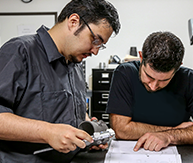 Training new employees or introducing a new process to existing employees is not a favorite pastime for most CNC shop owners. After all, if the chips aren’t flying…well you know the rest. That’s why it simply makes good sense to document procedures so that training sessions go more smoothly and employees have material to refer to on the job.
Training new employees or introducing a new process to existing employees is not a favorite pastime for most CNC shop owners. After all, if the chips aren’t flying…well you know the rest. That’s why it simply makes good sense to document procedures so that training sessions go more smoothly and employees have material to refer to on the job.
Although documentation requires a time investment up front, the payoff comes as the material is used multiple times. Of course the material you provide must be thorough and easy to understand, so here are a few guidelines to follow:
- Consider the best way to present your documentation. Some choices are:
- Step-by-step written instructions with appropriate illustrations and/or photos to clarify procedures. For example, instructions for creating a new part program would include the steps to follow and show screen shots of what the programmer will see on the control, plus photos of manual operations and machine movements.
- If the process is a complicated one, video may be an appropriate alternative to written instruction. A well-produced video provides a real-world look at how the steps are applied and what happens along the way. Although it’s tempting to simply set up a smart phone or digital camera and let it roll, studies show that video with good production values enhances learning.
- Combining written and video is an even more powerful approach. Just as some of us are right or left handed, we each have our own ways of processing new information. Therefore, combining written, verbal, visual and hands-on instruction is the most effective way to teach.
- Computers enable us to develop multi-media documentation that combines written, verbal and visual. Plus, with laptops or tablets employees can train right on the shop floor where they can experience the procedures hands-on.
- It’s best to establish a consistent format for documenting procedures. Otherwise each document will have variations that may inhibit learning. The best approaches are either to create a template into which text and images can be loaded, or to establish strict guidelines. For example, you could decide to use a basic presentation format (Introduction, Body, Conclusion) with specific instructions for each part of the presentation.
- Use consistent wording. People become confused if the terms in one training document are different than those in another. So use the most commonly accepted names for equipment, actions and processes every time. Also, be sure to provide specific information such as the precise type of material used to demonstrate a cutting technique, cutting tools used, etc.
- Don’t make training periods too long. As a society our attention span continues to shrink. For this reason it makes sense to break down complex training topics into bite-sized pieces. Think in terms of taking the learner to a logical stopping point in a process and recapping what’s been covered so far. You might even insert a brief quiz that the learners can use to assess their own progress. If they answer the questions correctly, they can proceed to the next step. If not, they should go back and revisit the training to that point.
To see some good examples of training videos, visit the Haas CNC Video Gallery and for everything you need to know about CNC machines and more, contact your Torrance Haas Factory Outlet. Call 310-381-0750, email: jphillips@haasfactoryoutlet.com, or visit www.haasfactoryoutlet.com.